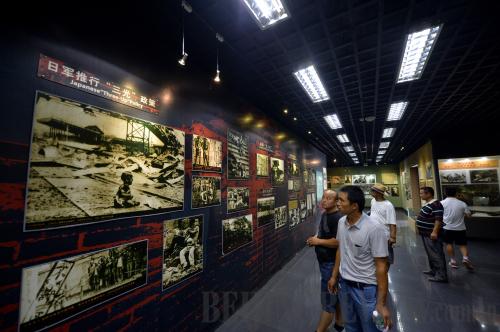

COMMEMORATING THE PAST: Visitors view historic photos from China's War Against Japanese Aggression at a memorial in Zhijiang, Hunan province, a county that witnessed the Japanese army's surrender to China in 1945 (BAI YU)
Sixty-nine years ago, on August 15, 1945, Japan unconditionally surrendered to the Allies, marking the end of China's War Against Japanese Aggression and World War II (WWII).
With the war ended and peace resumed in Asia, billions of people had the chance to breathe a sigh of relief, recover and rebuild their lives. This included about 70 million Japanese.
In memory of the hardship suffered and struggle waged by the Chinese people in this war, the Standing Committee of China's National People's Congress in February this year designated September 3 as the Victory Day of the War of Resistance Against Japanese Aggression, and December 13 as the National Memorial Day to commemorate over 300,000 Chinese killed by Japanese aggressors during the 1937 Nanjing Massacre.
The war years
The 69th anniversary presents one with the opportunity to remember a proud yet harrowing period of China's modern history. The War Against Japanese Aggression was a resounding victory for the Chinese but one that came at a terrible cost.
Early in 1931, the Japanese aggressors began plotting to conquer China's northeast provinces. On September 18 that year, Japanese officers incited the Mukden Incident, leading to the total occupation of Manchuria (northeast China) in five months.
The Japanese made further plans to conquer the north of China, where they planned to build up a continental base for their country's further territorial encroachment on the Asian continent.
Faced with a dire situation, the Communist Party of China (CPC) proposed a United Front between political parties, groups and armies against Japan.
Then came the Xi'an Incident in December 1936. Under the efforts of the CPC, Chiang Kai-Shek (1887-1975), then Chairman of the National Military Council of the Chinese Government, agreed to head the United Front. From thereon out, the Chinese people rallied around the Kuomintang (KMT) and the CPC to fight their common enemy.
The Japanese Army then bombarded Wanping, a county near Beijing on July 7, 1937, and started a full-scale war of aggression.
"From then on, the whole of China was engaged in an anti-invasion war, opening the first major anti-fascist battlefield in the world's East," said Peng Xunhou, a professor with the Academy of Military Science of the People's Liberation Army.
On August 13, 1937, the Japanese opened a second front in Shanghai, targeting China's economic capacity for war. Chiang deployed some of his best troops, which succeeded in stalling the enemy's advancement for three months.
Japanese tactics ultimately prevailed, causing a rapid disintegration of Chinese defenses. The enemy then swiftly advanced to the gates of the then-Chinese capital, Nanjing.
Chiang moved his capital to Chongqing, where the geographical surroundings made it all but impossible for the enemy to penetrate. This dashed Japanese hopes for a speedy resolution to the conflict.
Although the Japanese quickly captured all key Chinese ports and industrial centers, the combined KMT and CPC forces continued to resist them.
Copyright ©1999-2018
Chinanews.com. All rights reserved.
Reproduction in whole or in part without permission is prohibited.